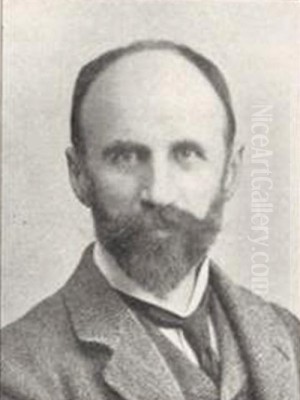
Julian Fałat, also known Józef Fałat, stands as a significant figure in the history of Polish art. Born on July 30, 1853, in Tuligłowy, near Lwów (now Lviv, Ukraine), he rose to prominence during a vibrant period of artistic development in Europe. His death occurred on July 9, 1929, in Bystra Śląska, Poland, concluding a life dedicated to capturing the nuances of the world around him, particularly through the medium of watercolor. He is celebrated not only as one of Poland's most accomplished watercolorists but also as a pivotal landscape painter and a key pioneer of Impressionism within the country.
Early Life and Artistic Formation
Fałat's artistic journey began formally at the Kraków School of Fine Arts. There, he studied under the guidance of Władysław Łuszczkiewicz, a notable figure in Polish art education who would later serve several terms as the institution's rector, long after Fałat's student years. This initial training laid the foundation for Fałat's technical skills and artistic sensibilities.
Seeking to broaden his horizons and deepen his artistic knowledge, Fałat continued his education abroad. He pursued further studies at the prestigious Academy of Fine Arts in Munich. This period exposed him to different artistic currents and techniques prevalent in one of Europe's major art centers at the time. While the provided sources mention his studies under Łuszczkiewicz in Kraków before moving to Munich, they suggest Łuszczkiewicz was also his mentor in Munich, which may indicate the strong continuing influence of his initial teacher or potentially conflates roles. Regardless, the Munich experience was crucial in shaping his development.
A Journey Around the World
A defining experience in Fałat's life and artistic career was his extensive journey undertaken in 1885. This year-long voyage took him across continents, encompassing travels through various parts of Europe and Asia. He meticulously documented his experiences and observations, gathering a wealth of sketches and notes that would serve as invaluable source material for his subsequent work.
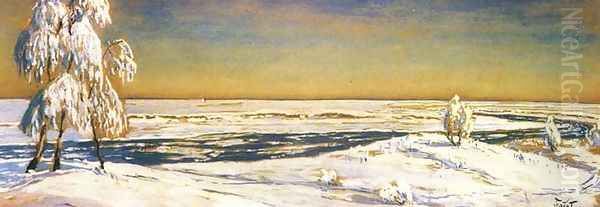
This global expedition profoundly influenced his artistic output. The diverse landscapes, cultures, and atmospheres he encountered broadened his thematic repertoire and refined his observational skills. His travel notes became a direct source of inspiration, enriching his depictions of Polish scenes with a more worldly perspective and a keener eye for detail and transient effects. The journey solidified his interest in landscape and genre scenes observed from life.
Artistic Style: Watercolor Mastery and Impressionist Leanings
Julian Fałat is perhaps best remembered for his exceptional skill with watercolors. He achieved a level of mastery in this medium that few contemporaries could match, making him arguably Poland's most distinguished watercolorist. His technique was characterized by a fluid, confident handling of the paint, allowing him to capture light, atmosphere, and texture with remarkable subtlety and vibrancy.
His preferred subjects often revolved around the Polish landscape, which he depicted with deep affection and understanding. He had a particular fondness for winter scenes, rendering snow-covered vistas with a unique sensitivity to the play of light and shadow on the white surfaces. Hunting scenes were another recurrent theme, capturing the energy and tradition of the Polish countryside. Beyond landscapes and hunting, his oeuvre also includes portraits and studies derived from his extensive travels.
Fałat is recognized as a leading figure and pioneer of Polish Impressionism. While developing his own distinct style, he embraced key tenets of the Impressionist movement, particularly its emphasis on capturing fleeting moments, the effects of light and atmosphere, and the use of a brighter palette. His works often exhibit the broken brushwork and attention to color theory associated with Impressionism, aiming to convey the sensory experience of a scene rather than just its topographical details. Although primarily a watercolorist, he also worked in oils, applying similar principles of light and color.
Representative Works and Techniques
Several works stand out as representative of Fałat's style and mastery. Paintings like Ogród (The Garden), dated 1908, and The Glade from 1917, exemplify his sophisticated watercolor technique. Art historians note his skill in pigment dispersion, the layering of transparent washes to create depth and luminosity, and the effective use of contrasting light and dark areas to structure his compositions.
His winter landscapes, such as works titled Winter or Berezin, showcase his ability to capture the specific quality of light in snowy environments. These paintings often convey a sense of stillness and crisp air, using subtle variations in white, blue, and grey tones to model the snow and depict atmospheric conditions.
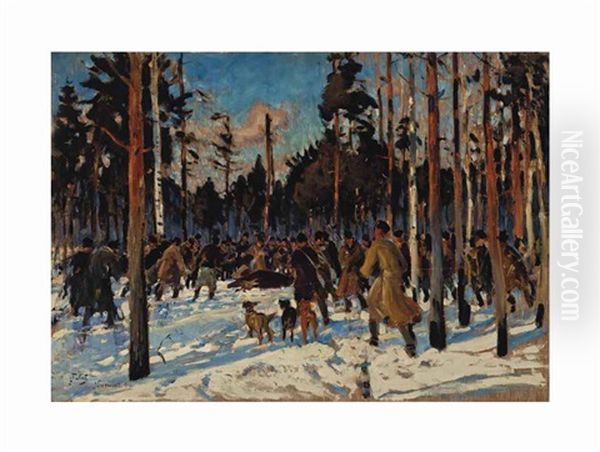
Two other notable works, Off to the Hunt (also known as The Trip to the Hunt) and The Hunt, gained notoriety for reasons beyond their artistic merit. These paintings highlight his interest in traditional Polish hunting themes, rendered with his characteristic dynamism and observational acuity.
Career Highlights and Recognition
Fałat's talent did not go unnoticed during his lifetime. A significant milestone occurred in 1886 when he was invited to Berlin to serve as a court painter to the future German Emperor Wilhelm II. This prestigious appointment involved documenting the Emperor's hunting expeditions, a task perfectly suited to Fałat's interests and skills. He shared this role for a time with fellow Polish artist Wojciech Kossak, with whom he also collaborated on other projects.
His time in Berlin brought him considerable recognition. In 1892, he was awarded the Grand Gold Medal at the Berlin Art Exhibition, a testament to his standing in the international art scene. His works were exhibited widely, not only in Poland but also in major European art centers like Munich, Vienna, and Berlin, solidifying his reputation beyond national borders.
One significant collaborative project undertaken with Wojciech Kossak was the creation of the "Berezyna" panorama, depicting a dramatic episode from the Napoleonic Wars. This large-scale work further demonstrated his ability to handle complex compositions and historical subjects, although he remained primarily known for his landscapes and hunting scenes.
Role as an Educator and Reformer
Beyond his personal artistic practice, Julian Fałat made substantial contributions to art education in Poland. In 1895, he was appointed Director (Rector) of his alma mater, the Kraków School of Fine Arts (later Academy of Fine Arts). He held this position until 1909 and implemented significant reforms during his tenure.
Fałat modernized the institution's curriculum, recognizing the need to align Polish art education with contemporary European trends. He introduced new courses and departments, notably strengthening the teaching of landscape painting and graphic arts. His vision was to foster a generation of artists who were technically proficient and creatively independent.
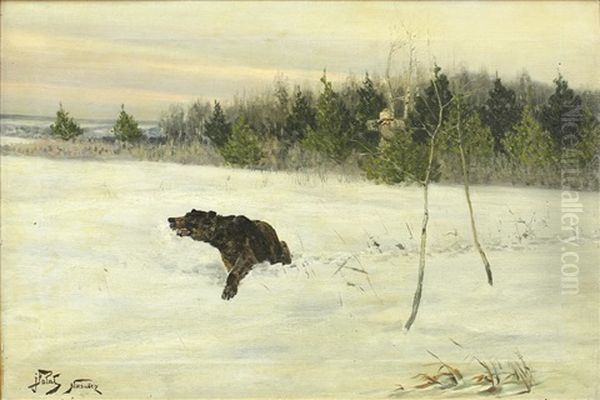
During his directorship, he attracted some of the most prominent Polish artists of the era to teach at the Academy. He appointed figures such as Jacek Malczewski, Leon Wyczółkowski, Jan Stanisławski, Teodor Axentowicz, Stanisław Wyspiański, and Józef Mehoffer as professors. This assembly of talent transformed the Kraków Academy into a leading center for artistic innovation and a crucible for the Young Poland (Młoda Polska) movement. Fałat's leadership thus had a lasting impact on the development of Polish art in the early 20th century.
Influence of Japanese Art
Fałat's artistic explorations extended to non-European traditions. He developed a keen interest in Japanese art, particularly Ukiyo-e woodblock prints, which were gaining popularity among European artists in the late 19th century. He admired their compositional elegance, flattened perspectives, and decorative qualities.
Elements inspired by Japanese aesthetics can be discerned in some of Fałat's works, especially his later winter landscapes. This influence might manifest in the arrangement of forms, the use of line, or a certain simplification and stylization. This engagement with Japonisme added another layer to his artistic practice and contributed to his unique position within the Polish art scene.
Contemporaries and Artistic Milieu
Julian Fałat worked during a rich period in Polish and European art. His most notable collaborator was Wojciech Kossak (1856–1942), with whom he worked in Berlin and on the Berezyna Panorama.
As Rector in Kraków, he directly interacted with and appointed leading figures of the Young Poland movement:
Jacek Malczewski (1854–1929)
Leon Wyczółkowski (1852–1936)
Jan Stanisławski (1860–1907)
Teodor Axentowicz (1859–1938)
Stanisław Wyspiański (1869–1907)
Józef Mehoffer (1869–1946)
His teacher, Władysław Łuszczkiewicz (1828–1900), was also a significant figure from the preceding generation.
The provided sources also list other artists active during overlapping periods, though without confirmed direct interaction with Fałat (beyond Kossak):
Jerzy Fedkowicz (1891–1959), a later Polish painter.
Friedrich Feigl (Bedřich Feigl) (1884–1965), a Czech painter.
Károly Ferenczy (1862–1917), a prominent Hungarian painter associated with the Nagybánya artists' colony.
Emil Fuchs (1866–1929, though source listed 1862-1917), an Austrian-American sculptor, medallist, and painter.
Alfred Forbat (1897–1972, though source listed 1858-1932), a Hungarian architect and painter associated with the Bauhaus. (The dates provided in the source for Forbat seem incorrect when cross-referenced with standard biographies, but are included here as per instruction).
While direct interactions with many of these figures (apart from Kossak and the Kraków professors) are not documented in the provided text, their concurrent activity illustrates the broader artistic context in which Fałat worked.
Students and Legacy
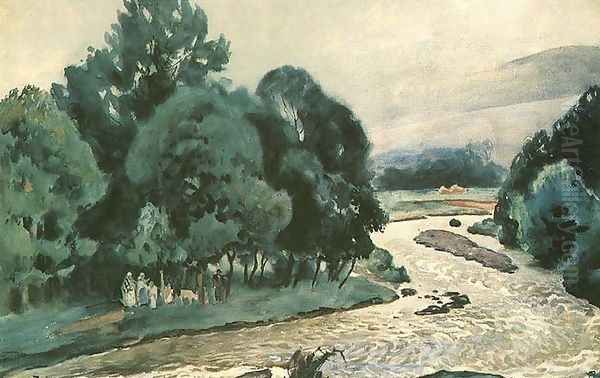
The provided information does not contain a specific list of Julian Fałat's students or disciples. While he was a highly influential figure and the head of a major art academy, the sources focus more on the established artists he appointed as professors rather than individuals he personally mentored as pupils. His influence was likely felt more broadly through his reforms and the overall direction he set for the Kraków Academy.
Fałat's legacy, however, is undeniable. He is consistently ranked among the most important Polish artists of his generation. His mastery of watercolor set a high standard and influenced subsequent generations of Polish painters. His role in introducing and adapting Impressionism to the Polish context was crucial for the modernization of painting in the country.
His dedication to Polish themes, particularly landscapes and hunting traditions, ensured his enduring popularity. His works are held in major Polish museums, including the National Museums in Warsaw, Kraków, and Poznań. A dedicated museum, the Fałatówka branch of the Museum in Bielsko-Biała, operates in his former villa in Bystra, preserving his memory and showcasing his life and work.
The Fate of Looted Art
Fałat's significance is also highlighted by the fate of some of his works during times of conflict. During World War II, numerous Polish cultural treasures were looted by Nazi Germany. Among these were Fałat's paintings Off to the Hunt and The Hunt. These works disappeared for decades, believed lost or destroyed.
However, through international cooperation and the efforts of restitution authorities, the paintings were eventually located in the United States. In 2010, after being recovered by US agencies, the two paintings were officially returned to Poland in a ceremony held in New York. This event underscored the cultural importance of Fałat's work and the ongoing efforts to recover art looted during the war. The return of these paintings was celebrated as a significant moment for Polish cultural heritage.
Final Years and Enduring Influence
Julian Fałat spent his final years in Bystra Śląska, where he had built a villa. He passed away there on July 9, 1929. His contributions to Polish art remain highly valued. He successfully navigated the transition from 19th-century academic traditions towards modernism, embracing Impressionism while retaining a unique personal style deeply rooted in his Polish identity. His watercolors, in particular, continue to be admired for their technical brilliance and evocative power, securing his place as a master of the medium and a key figure in the landscape of Polish art history. His son, Kazimierz Fałat (known as Togo), also became an artist, continuing the family's artistic pursuits, primarily in watercolor.